#Amur River
Explore tagged Tumblr posts
Video
Komsomolsk-on-Amur 10 by Alexxx Malev Via Flickr: Russia. Komsomolsk-on-Amur. Amur River Комсомольск-на-Амуре. Амур
#2015#amur river#city#crane#july#khabarovsk krai#komsomolsk-on-amur#river#russia#summer#амур#город#июль#комсомольск-на-амуре#кран#лето#река#россия#хабаровский край#flickr#russian tumblr#русский tumblr
6 notes
·
View notes
Text
The Dragon and the Bear: China's Quiet Quest to Reclaim the Russian Far East
The Dragon and the Bear: China's Quiet Quest to Reclaim the Russian Far East
Introduction: The Shadow of the Century of Humiliation and the Sino-Russian Power Dynamics In the labyrinthine corridors of international politics, the Sino-Russian relationship stands out as a beacon of strategic partnership and historical complexity. Rooted in a turbulent past and blossoming in a pragmatic present, this alliance between two neighboring giants is underscored by a long history of…
#Aigun#Amur Annexation#Amur River#and lessons from history#Asia-Pacific#Asian countries#Asian politics#Beijing#Belt and Road Initiative#Blagoveshchensk Massacre#border disputes#Boxer Uprising#brain drain#brain drain impact#Century of Humiliation#China#China foreign policy#Chinese diaspora#Chinese investments#Chinese nationalism#Cold War dynamics#containment strategy#Convention of Peking#cultural diplomacy#cultural exchange#cultural ties#cyber technologies#cybersecurity#defense strategies#demographic pressures
0 notes
Text
But this summer was different: along the banks of the Shilka River (Figure 9.5) a tent town sprang up and hundreds of Chinese negotiators, using Christian missionaries to present their terms in Latin, sat down with grizzled Russians to work out a mutual frontier.*

*They did a good job; the border is still where they set it, on the Amur River. The latest negotiations, in July 2008, moved the line just a mile or two across an island within the river.
"Why the West Rules – For Now: The patterns of history and what they reveal about the future" - Ian Morris
#book quotes#why the west rules – for now#ian morris#nonfiction#summer#shilka river#tent town#chinese#christian missionaries#latin#russians#frontier#borders#negotiations#amur river#17th century
0 notes
Video
Sayan at the "river" by Tambako The Jaguar Via Flickr: Next photo of Sayan, the male Siberian tiger
#amur tiger#animal#d6#looking#male#mammal#nikon#pacing#river#rock#siberian tiger#standing#stone#sunny#switzerland#tiger#vegetation#walking#water#winter#zoo#zürich#flickr
77 notes
·
View notes
Text
#genomes#sinitic people#neolithic yellow river farmers#han chinese 90-95%#korean#20 % amur river hunters#tungusic and mogolic ancestors#japanese 20% dna amur river hunters#20 % jomon hunter/gather ancestry
0 notes
Text

The Amur River passes through the city of Khabarovsk, spreading out into a dramatic braided pattern on its path through eastern Russia. As the world’s tenth-longest river, the Amur flows 1,755 miles (2,824 km) to form much of the border between the Russian Far East and Northeastern China. The first permanent bridge across the Amur was built in Khabarovsk in 1916, allowing the Trans-Siberian Railway to cross the 1.6-mile (2.6 km) span more efficiently.
48.536111°, 135.000000°
Source imagery: Planet
752 notes
·
View notes
Text
Wet Beast Wednesday: common carp
Welcome to the first WBW of fresh-uary. All my Wet Beast Wednesday posts this month will be about freshwater species. And where better to start than one of the most prolific and invasive freshwater fish, the common carp. Introduced worldwide as a food species, the common carp population has exploded due to them being masters of survival. Lets see how they have become so prevalent.

(Image: a common carp seen from the front and side. It is a large fish with a pointed head ending in a downward-pointing mouth with short barbels at the sides. The scales are large and orangeish. End ID)
The common carp, Cyprinus carpio, also known as the European carp or Eurasian carp is a large bony fish with a robust body and large, yellow-brown scales. Common carp have a downturned mouth with two pairs of short barbels, one emerging from the sides of the mouth and one from the lower lip. There are distinct wild and domesticated forms, with the wild ones being longer and slimmer. Most wild type common carp reach an average of 40-80 cm (16-31 in) long and 2-14 kg (4.5-31 lbs), but under the right conditions, they can get much larger. The largest common carp on record weighed 45.59 kg (100.5 lbs). Domesticated common carp can get much larger than wild ones and grow at almost twice the rate. Common carp have also been selectively bred into additional morphs, the most common of which is the mirror carp, so named for its much larger scales. Carp that are missing some or all of their scales are called leather carp and they often lose their scales as the result of a mutation. Mirror carp are especially prone to losing scales. The Amur carp, Cyprinus rubrofuscus, was previously considered to be a subspecies of the common carp before being reclassified as a closely related species. The two species are capable of hybridizing. They can also hybridize with goldfish.

(Image: a common carp seen from the side. From this angle, it is easier to see a small hump behind the head where the back begins. End ID)
Common carp are native to southern Europe and west Asia, particularly in the Danube river basin. Their preferred habitat is warm, still or slow water, but they are notorious for their ability to survive fairly extreme conditions. Carp can live in a wide range of temperatures, in highly polluted water, in more salty water than most freshwater fish, and in low-oxygen water (by gulping air at the surface). They also tolerate very shallow water for their size. I've personally pulled 2-foot long carp out of ankle-deep water. Carp are bottom-feeding omnivores that feed by rooting around in soft sediment. Food includes aquatic plants, algae, fish eggs, worms, small invertebrates like crayfish, and small fish. Carp feeding kicks a lot of sediment into the water, which can reduce water quality and encourage eutrophication. They will pick up sediment in their mouths and pass it back and fourth, using their gill rakers to filter out edible material. They have a set of pharyngeal teeth used to grind up food. Carp can be found solitary, but prefer to swim in small schools.

(Image: a common carp feeding. It has its head to the bottom sucking in corn kernels that the photographer has scattered around to attract them. This one has large, irregular scales, indicating it may be a mirror carp)
Carp reproduce in spring, often triggered by seasonal flooding. They will spawn multiple times during a season, with an average female able to produce over a million eggs per year. Females lay their eggs in shallow water, where they stick to vegetation. Carp in non-vegetated areas will make seasonal migrations to more suitable habitat for spawning. Juvenile carp are vulnerable to predators and rely on vegetation to hide. They feed on plankton until they grow large enough to root around in the sediment. Males reach sexual maturity between ages 3 and 5 and females between ages 4 and 6, with those living in warmer water maturing faster. Carp can live for decades, with the oldest one on record being 64 at the time of death.

(Image: a group of 10 common carp swimming at the surface of the water. Some of them have their mouths sticking out. End ID)
Carp have been raised for food for millennia, with the oldest record of them being farmed being Roman times. This is likely also when the domesticated variety diverged from the wild type. Carp is a major food source throughout Europe and Asia, but is unpopular as food in North America because of how bony they are. The wide use of carp in food has contributed to them being spread across the world. Common carp can now be found on every continent except Antarctica and in every region except for polar ones that are too cold for them. Common carp are one of the most invasive of all fish species and tend to be highly destructive to habitats they are introduced to. Their feeding tends to uproot and destroy aquatic vegetation and native fish eggs while outcompeting native species with similar niches. Carp feeding kicks up lots of sediment in the water and can radically change the conditions of waters they are introduced into. Various carp control methods have been introduced to try to keep their numbers down. These include barricades to prevent them from reaching spawning grounds, capture and kill programs, and the use of poison. In many places carp have been introduced to, fishing for food and sport helps control their numbers. One of the problems with carp in North America is that there isn't a food market for them and many anglers don't target them. Environmentalists have been working on encouraging carp fishing and telling anglers to kill carp they catch to help control their numbers. Carp aquaculture has become a major industry. China produces more carp by weight yearly than all other fish from aquaculture worldwide. Ironically, despite their invasive nature and survivability, wild common carp in their native range are considered threatened due to habitat loss.

(Image: three excited-looking people holding up a giant common carp. The fish is so big that even with all three people standing shoulder to shoulder, the fish extends across all of them. End ID)
#wet beast wednesday#common carp#carp#fish#fishblr#fishposting#freshwater fish#freshwater#freshwater ecology#ecology#zoology#biology#invasive species#informative#educational#animal facts#image described
93 notes
·
View notes
Text
Daily fish fact #875
Amur pike!

Its natural range is the Amur river basin and the island of Sakhalin. Juvenile Amur pikes have dark stripes on their sides for camouflage, which develop later into black-spotted colouration of the adults!
#fish#biology#fish facts#fishfact#zoology#fishblr#amur pike#pike#blackspotted pike#black-spotted pike
58 notes
·
View notes
Text

Amur Leopards are a subspecies of leopards that live in the Amur River region of Russia, North Korea, and China. Less than 500 amur leopards remain in the wild.
57 notes
·
View notes
Text
Fishskin Robes of the Ethnic Tungusic People of China and Russia
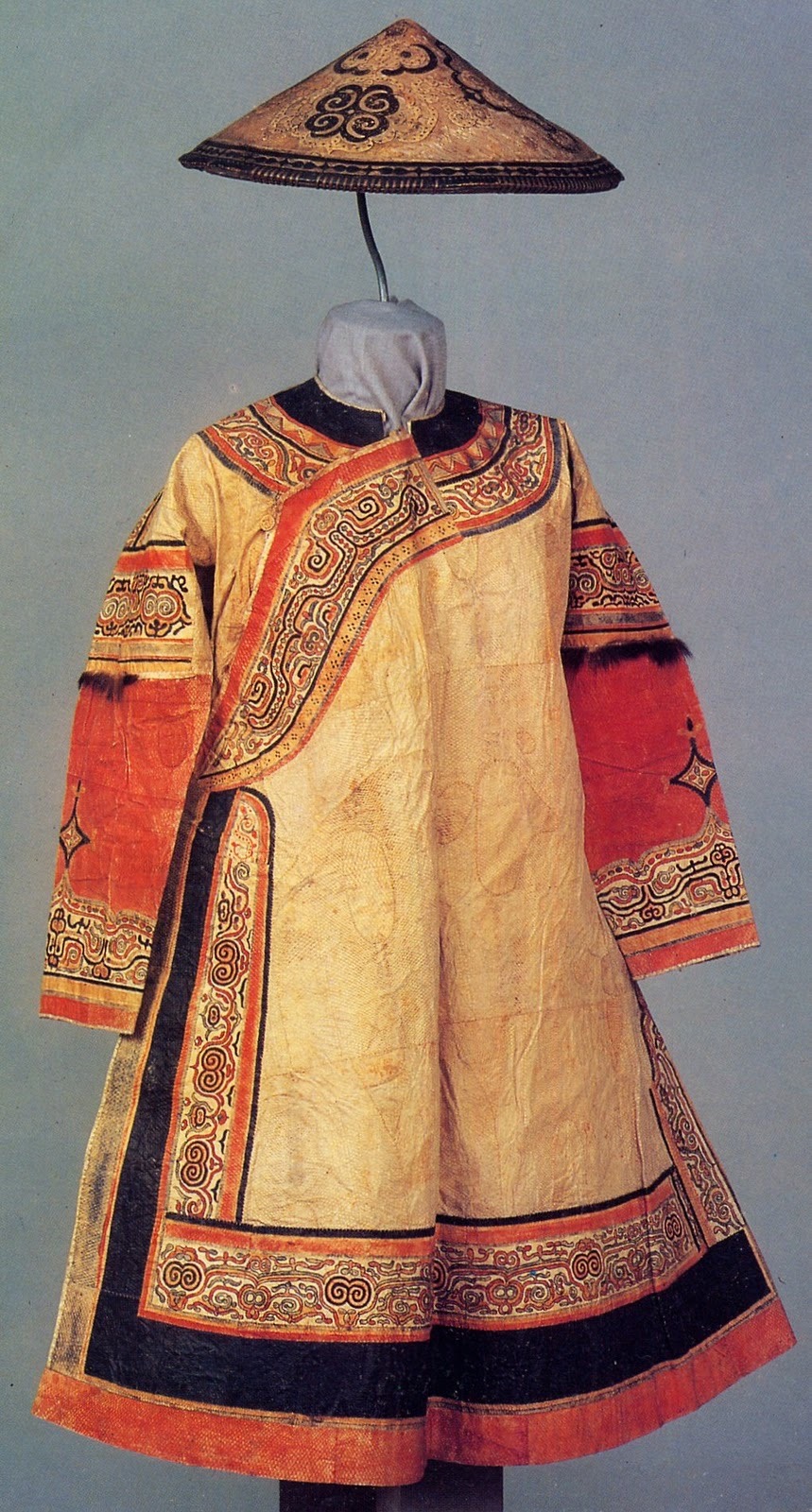
Oroch woman’s festive robe made of fish skin, leather, and decorative fur trimmings [image source].
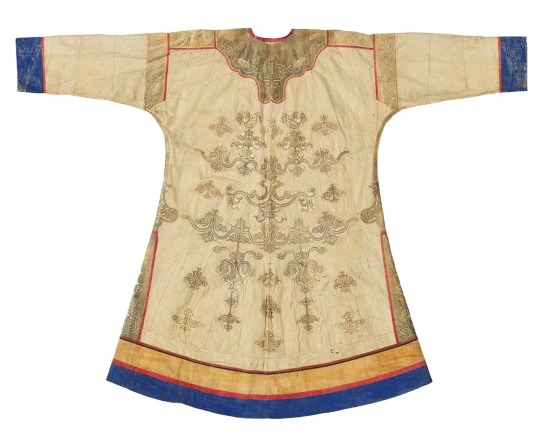
Nivkh woman’s fish-skin festival coats (hukht), late 19th century. Cloth: fish skin, sinew (reindeer), cotton thread; appliqué and embroidery. Promised gift of Thomas Murray L2019.66.2, Minneapolis Institute of Art, Minnesota, United States [image source].
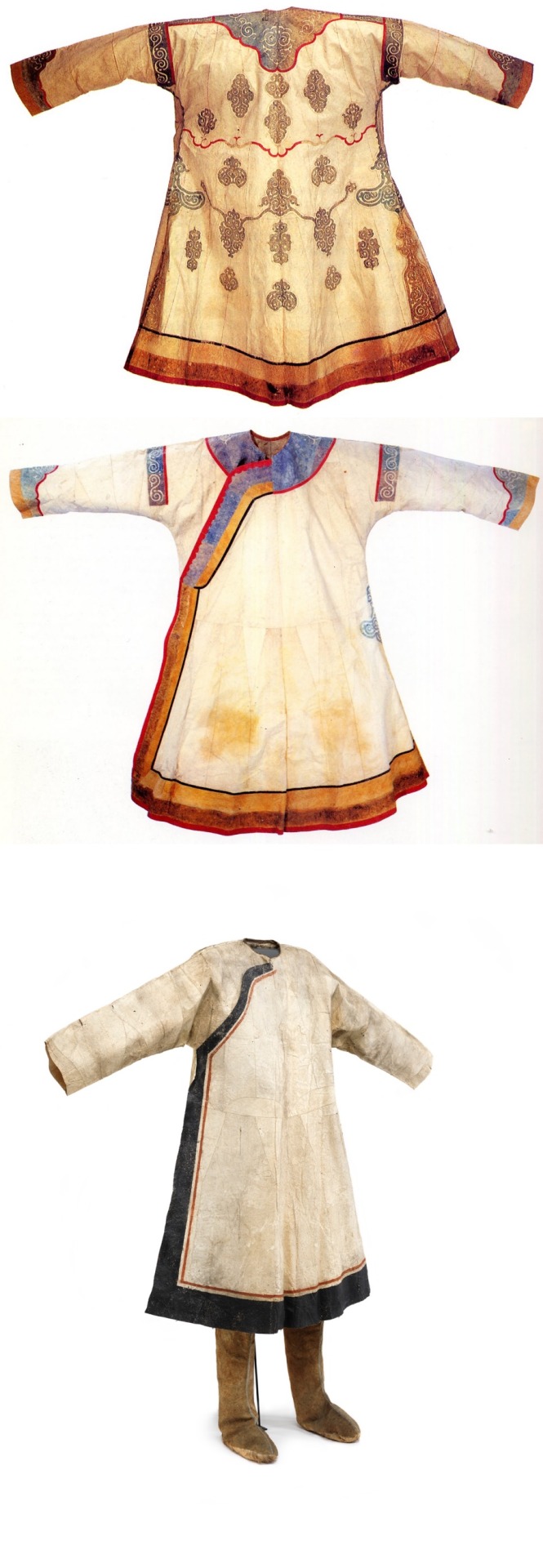
Back view of a Nivkh woman’s robe [image source].
Front view of a Nivkh woman’s robe [image source].
Women’s clothing, collected from a Nivkh community in 1871, now in the National Museum of Denmark. Photo by Roberto Fortuna, courtesy Wikimedia Commons [image source].
The Hezhe people 赫哲族 (also known as Nanai 那乃) are one of the smallest recognized minority groups in China composed of around five thousand members. Most live in the Amur Basin, more specifically, around the Heilong 黑龙, Songhua 松花, and Wusuli 乌苏里 rivers. Their wet environment and diet, composed of almost exclusively fish, led them to develop impermeable clothing made out of fish skin. Since they are part of the Tungusic family, their clothing bears resemblance to that of other Tungusic people, including the Jurchen and Manchu.
They were nearly wiped out during the Imperial Japanese invasion of China but, slowly, their numbers have begun to recover. Due to mixing with other ethnic groups who introduced the Hezhen to cloth, the tradition of fish skin clothing is endangered but there are attempts of preserving this heritage.
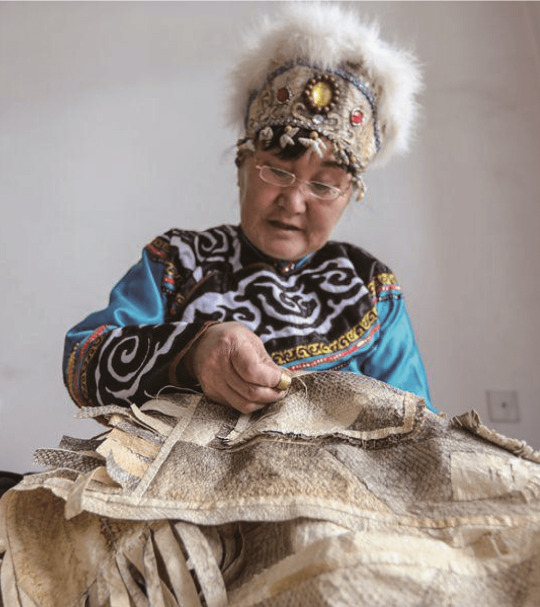
Hezhen woman stitching together fish skins [image source].


Top to bottom left: You Wenfeng, 68, an ethnic Hezhen woman, poses with her fishskin clothes at her studio in Tongjiang, Heilongjiang province, China December 31, 2019. Picture taken December 31, 2019 by Aly Song for Reuters [image source].
Hezhen Fish skin craft workshop with Mrs. You Wen Fen in Tongjian, China. © Elisa Palomino and Joseph Boon [image source].
Hezhen woman showcasing her fishskin outfit [image source].
Hezhen fish skin jacket and pants, Hielongiang, China, mid 20th century. In the latter part of the 20th century only one or two families could still produce clothing like this made of joined pieces of fish skin, which makes even the later pieces extremely rare [image source].
Detail view of the stitching and material of a Hezhen fishskin jacket in the shape of a 大襟衣 dajinyi or dajin, contemporary. Ethnic Costume Museum of Beijing, China [image source].
Hezhen fishskin boots, contemporary. Ethnic Costume Museum of Beijing, China [image source].
Although Hezhen clothing is characterized by its practicality and ease of movement, it does not mean it’s devoid of complexity. Below are two examples of ornate female Hezhen fishskin robes. Although they may look like leather or cloth at first sight, they’re fully made of different fish skins stitched together. It shows an impressive technical command of the medium.
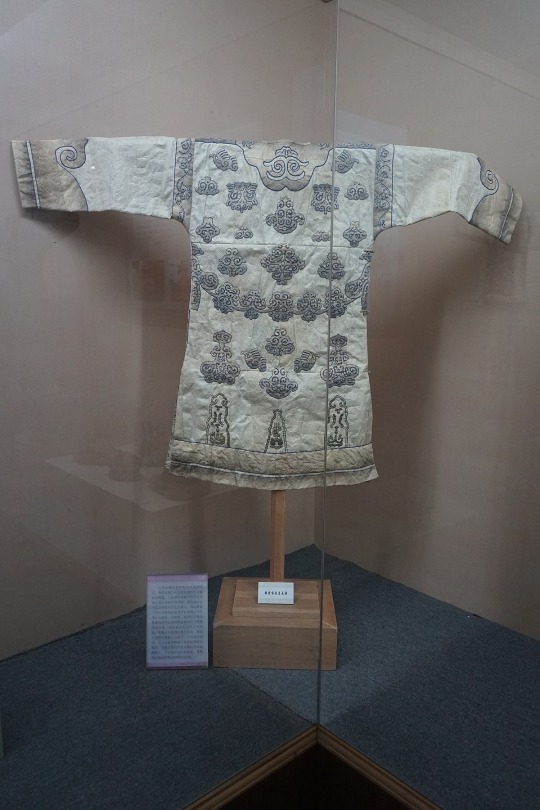
赫哲族鱼皮长袍 [Hezhen fishskin robe]. Taken July 13, 2017. © Huanokinhejo / Wikimedia Commons, CC BY 4.0 [image source].
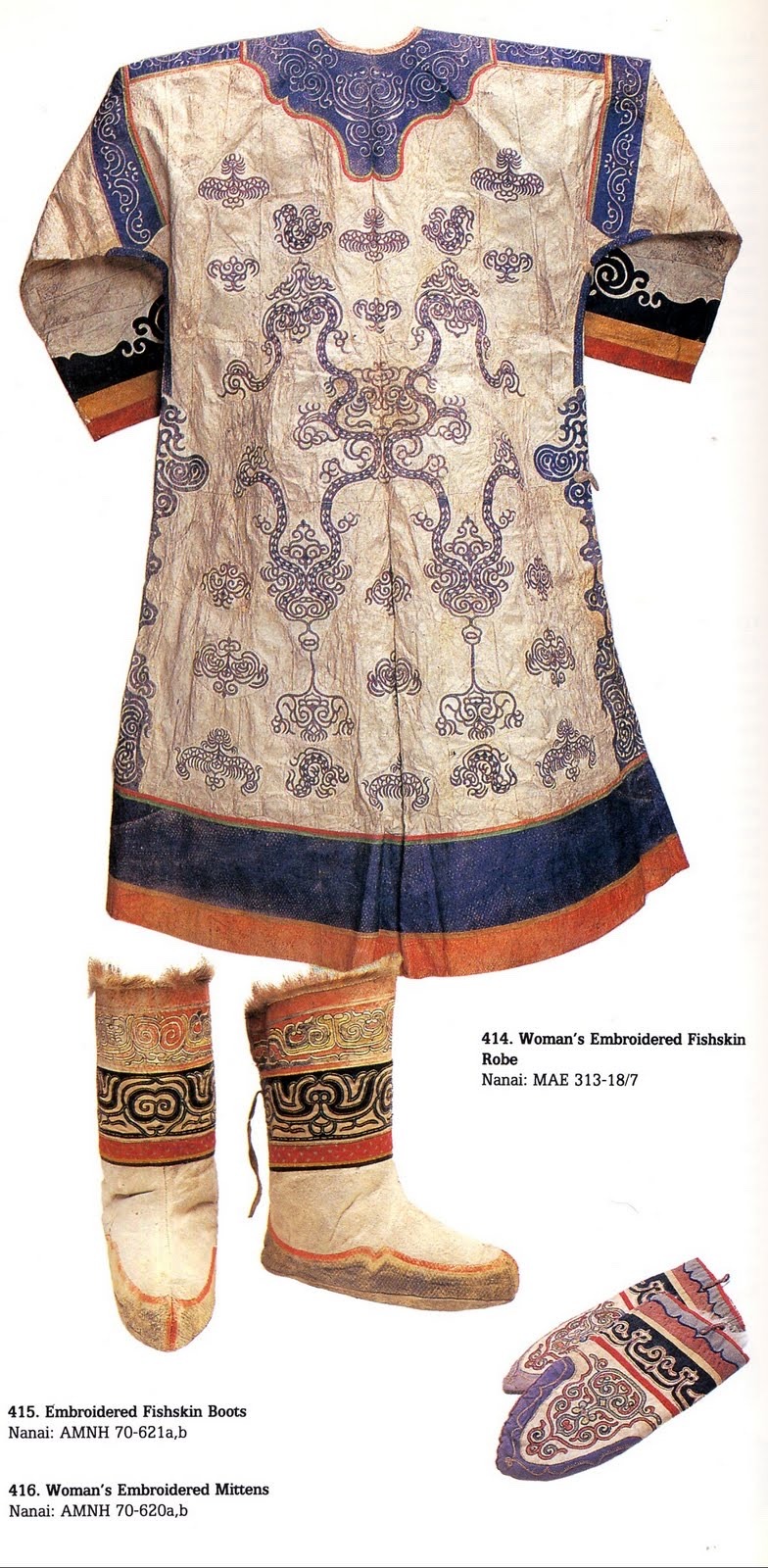
Image containing a set of Hezhen clothes including a woman’s fishskin robe [image source].
The Nivkh people of China and Russia also make clothing out of fish skin. Like the Hezhen, they also live in the Amur Basin but they are more concentrated on and nearby to Sakhalin Island in East Siberia.


Top to bottom left: Woman’s fish-skin festival coat (hukht) with detail views. Unknown Nivkh makers, late 19th century. Cloth: fish skin, sinew (reindeer), cotton thread; appliqué and embroidery. The John R. Van Derlip Fund and the Mary Griggs Burke Endowment Fund; purchase from the Thomas Murray Collection 2019.20.31 [image source].
Top to bottom right: detail view of the lower hem of the robe to the left after cleaning [image source].
Nivkh or Nanai fish skin boots from the collection of Musée du quai Branly -Jacques Chirac. © Marie-Lan Nguyen / Wikimedia Commons, CC BY 4.0 [image source].
Detail view of the patterns at the back of a Hezhen robe [image source].
Read more:
#china#russia#tungusic#hezhe#nanai#fishskin#ethnic minorities#nivkh#chinese culture#history#russian culture#amur basin#heilongjiang#east siberia#ethnic clothing
1K notes
·
View notes
Video
Amursk 19 by Alexxx Malev Via Flickr: Russia. Amursk. Amur River Амурск. Амур
#2015#amur river#amursk#city#july#khabarovsk krai#river#russia#summer#амур#амурск#город#июль#лето#река#россия#хабаровский край#flickr#russian tumblr#русский tumblr
4 notes
·
View notes
Text
MerMay + Defense Class
Hey they found something shiny :D

Demoman - Seal / Pinniped (based on Selkie in Norse and Celtic mythology)
Engineer - Guadalupe bass / Micropterus treculii (State Fish in Texas)
Heavy - Kaluga / River Beluga / Huso dauricus (Sturgeon found in the Amur River basin ; Weighs 1,000 kg / 2,205 lb and 5.6 m. / 18.6 ft. max. + one of the biggest of the sturgeon family)
{ Offense } {Defense; Here} { Support }
Proships DNI
Reblogs > Likes
#i'm almost done with the tf2 mermay stuff lets goooo :D#tf2#my art#mermay#mermay 2024#tf2 defense team#tf2 engineer#engineer tf2#demoman my belemoman#tf2 demoman#heavy tf2#tf2 heavy#fish on#(a lot of talk about fish here)#tf2 fanart
55 notes
·
View notes
Text
stardew valley fave animal HCs ^0^
i've wanted to post this for a bit!!!!!! i thought of em all >:3 !! PLEASE NOTE NONE OF THIS IS CANON -- ALL OF THESE ARE HEADCANONS I THOUGHT UP !! ALL FOR EDUCATIONAL PURPOSES TO LEARN AND KNOW MORE ANIMAL SPECIES THAT MIGHT BE GOING EXTINCT !!! GIANT NERD ALERT !! ` ------------------------------------------------------ Leah fox, specifically Red Fox (Cross Pelt; AKA Cross Fox) and Painted Dogs. Enjoys the Art side of their pelts and adores how they blend in. In her own words, "The art of Nature is within the Fur of the owner" (extra: hognose snake, chameleon) Abigail Mongolian wildcat, panther. Enjoys the cute side of cats as well as the hardcore style of them as well (hence the panther), totally has a panther tattoo somewhere (extra: Bombay cat, silver-pelted red-fox) Emily Aye-aye, monkeys. LOVES little baby monkeys, goes onto rants how she would make dresses for them like the ones on the internet. finds the Aye-aye to be misunderstood-- their cute yet creepy faces making her lil heart melt. no one understands why she likes them so much (extra: rainbow trout) Haley Tigers (White pelt). Firm believer of the "big cat bigger heart". Adores how gorgeous they are, how shiny the pelts look. Though a large lover of all tiger pelts, the black stripes against white fur struck her interest more (extra: leopard, painted dog) Maru Dolphin, Otters (River). really enjoys sea animals, but yet loves smart animals. She believes that they're misunderstood creatures, defending them with all her heart (extra: emperor penguin) Penny Giraffe, Bear (Kodiak breed). LOVES how beautiful they are, yet they keep to themselves. She isn't loud about her love of these animals but yet shares if mentioned (She's usually called a mama bear by the children of Pelican town) (extra: Harp seal) ------------------------------------------- Harvey Whale (Blue whale), Bernese mountain dog. When he was young he owned a Bernese Mountain dog-- Often talks about her when dogs are the topic. "She was the sweetest thing" he often states. Whales are his weird enjoyment, does A LOT of research on them & goes whale watching at the beach. Watched a film where they were flying overhead the main characters like airplanes!! loved them ever since (extra: Holland lop, African bush elephant, glass toad) Elliott (OTHER THEN LOBSTERS I SEE UR REPLIES FROM THE FUTURE) Amur Leopard, Vaquita . enjoys how gorgeous these animals are, the big doe eyes of these creatures giving him a little dopamine. Gets fairly upset once he learned the extinction of the Vaquita (extra: khaki Campbell duck ) Alex Ploughshare Tortoise, Golden retriever. Has had a little tortoise since he was young, he named him "Junior" but spelt it like "joonyer". Alex is very on that "Golden retriever boyfriend" trend and tries his best to be that
(extra: fried egg jellyfish, dik-dik) Shane (OTHER THEN CHICKENS) Hirola (Antelope) and Ant eater (southern tamandua). Finds them so weird, yet finds them so lonely. Finds himself looking into the eyes of Prey and relating so harshly. (extra: hereford cow, tamworth pig) Sebastian (OTHER THEN FROGS. GRRR) Ili Pika , deer ( Axis breed ). Adores cute little animals that own the biggest eyes, yet chose these little critters. Looks up pictures of them and cries (extra: slow loris , axolotl) Sam pangolin ( Philippine breed ) , Bush Dog . Found out about Pangolins through Pokemon, fell in love and looked into Pangolins more. Bush dogs are like little bear cubs to him-- yet has been attacked by one before. Does NOT care though finds them so cute
(extra: sugar glider, duck-billed platypus) ----------------------------------------------------------------- YAYYYYYAYAYAYYYY U GOT TO THE END YAYY
#stardew#stardew valley#SDV#educate yourself#animals#stardew valley headcanons#sdv bachelors#sdv bachelorettes#headcanons#headcanon#my headcanons#not canon#i can post whatever i want#so i post nerd shit#nerd#favorite animal#sdv harvey#sdv elliott#sdv sam#sdv shane#sdv sebastian#sdv alex#sdv penny#sdv leah#sdv abigail#sdv maru#sdv emily#sdv haley
30 notes
·
View notes
Text
Been a real "history of the Soviet Union" year so far. Amur River by Colin Thubron, Sovietistan by Erika Fatland, Central Asia by Adeeb Khalid, about to start Ronald Grigor Suny's biography of Stalin, read a few pages into Collapse by Vladislav Zubok the other day, the whole Estonia thing I had a few weeks back, arguably my current Counter Strike thing,
49 notes
·
View notes
Text
hypothesis on the ethnic/cultural background of izutsumi's mom
[disclaimer: i am not a professional ethnographer, nor of any of the ethnic groups mentioned in the post. this post was written based on research done over the course of a day.
if you have any corrections, feedback, etc, please feel free to inform me! my inbox/dms are open. if there is any misinformation present, i aim to correct them] ----------
idk if anyone else into dungeon meshi has noticed this, but i think izutsumi's mom (and therefore, izutsumi herself) might've been of Nivkh (indigenous east Siberian) heritage?
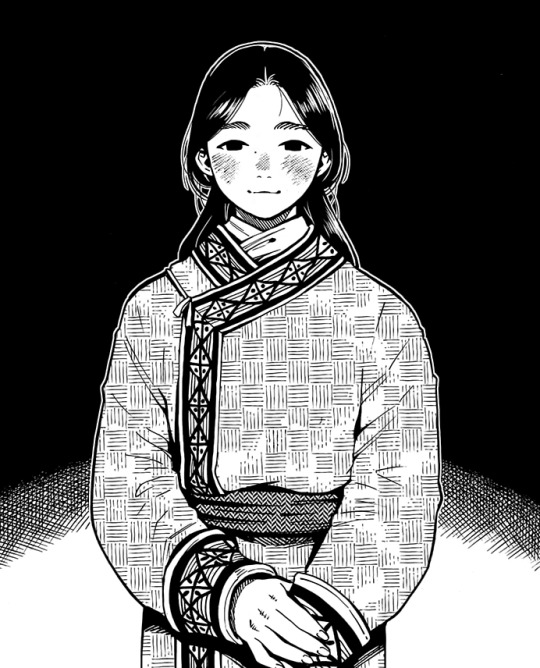
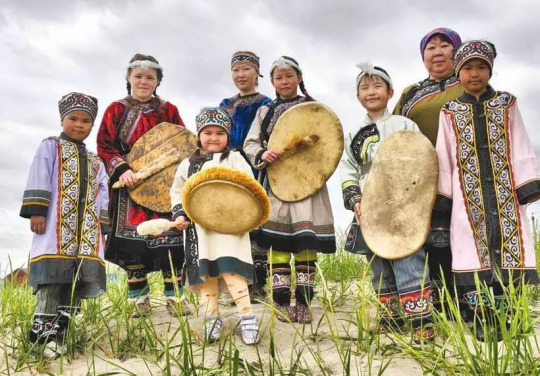
[details and explanation under the readmore, its slightly long]
when dungeon meshi chapter 59 came out (~2019), i saw a few people speculating that izutsumi's mom might've been Ainu because of how her clothing style notably differed from typical Japanese clothing.
while the Nivkh robe's trim features a different pattern style (swirly) than what izutsumi's mom wears (triangular), the Nivkh robe still looks to be a closer match than Ainu robes, especially in the collar/neckline & sleeve cuff areas.
note how the Ainu robes (image 2) have a different neckline style and wider sleeves:


heres more images of the robes, but from the past this time, found in Wikimedia Commons:
image 1: Nivkh robe from 1871 image 2: Sakhalin Ainu girl (left), Nivkh boy (center), Hokkaido Ainu girl (right) in 1912


Nivkh people have had interactions with Japan dating back centuries too. heres an exerpt from wikipedia:
"For many centuries, the Nivkh were tributaries of the Manchus. After the Treaty of Nerchinsk in 1689, they functioned as intermediaries between the Russians, Manchu and Japanese, and also the Ainu, who were vassals of the Japanese. Early contact with the southern Sakhalin Ainu was generally hostile, although trade between the two was apparent"
(sorry historians for quoting wikipedia as a source here. a lot of the more reputable sources are 20-200+ page papers, and not concise enough to put on a tumblr post)
the English language wiki doesnt have much more detail on Nivkh-Japan relations unfortunately, but there seems to be more info on the Japanese language version of the page.
i've also seen at least 1 speculation that izutsumi's mom might be Mongolian, as her robe somewhat resembles a Mongolian deel. in my opinion, the robe's neckline trim having patterning makes it resemble the Nivkh robes more. this – combined with the fact that prior to the 1900s, Japan-Mongolia relations consisted mostly of Mongolian forces trying to invade japan repeatedly – makes me think Nivkh (or some other indigenous east Siberian) heritage is more likely.
i wont rule it out entirely though, as i don't know how much Ryōko Kui cares about historical-based cultural relations. regardless, here are various deel styles across different Mongolian ethnic groups, if that is of interest to anyone:
i dont really have a profound conclusion for this post tbh. i wanted to document what i found, and figured i might as well share it to tumblr.
theres limited amounts of easily accessible information on traditional eastern Siberian clothing out there, but here's 1 source i found that goes over a few groups (including Nivkh):
#dungeon meshi#izutsumi#delicious in dungeon#izutsumi dungeon meshi#ryoko kui#kui ryoko#mynn.txt#cross-posting this from the tweet thread i made at like 5am. but with more grammatical edits and more detailed info#my first 'formal' theory post i hope its not too bad lol
348 notes
·
View notes
Text
A Metamorph and Her Forms
Before I begin, I want to note a few things about my nonhuman identity and how it works.
I'm a metamorph and one of the things I do the most is shapeshift. It is both voluntary and involuntary. I can willingly choose to change my shape if I concentrate or, a shift can happen due to external stimuli such as media influence, extreme emotions, or environmental situations.
No, I'm not a polytherian or polykin. This terms don't work for me. When I'm not shifted as anything, I have what I call a default form that is quite literally nothing, as I put it. I feel weightless and fluid, moving similar to smoke but with the tangibility of water. For those who haven't seen, this is my artistic rendition of my default form.
So, to basically put it, I'm an entity that shapeshifts, or 'mimics', into other forms. (Which, let me tell you, has been hell to figure out for these past 15 years.) I've also had a friends say I'm a kintype empath. I see something, then become that thing (appearance, traits, quirks, characteristics, instincts, everything).
Anyways, I thought I'd take some time to list forms I've taken from most used to least used! (Seemed like a fun idea ^^)
Let's get started! ˏˋ°•*⁀➷
My Top 5 Forms
: ̗̀➛ Leopard This can be either an amur leopard or snow leopard depending on temperature. The colder it is, the more likely I take on a snow leopard form. As of recently, it is the most common form I shift into it.
: ̗̀➛ Fox Before I confirmed being a metamorph (my own official label for what I am), I thought I was a kitsune/fox. The form is still a preference and therefor ranks second in forms I like to shift into. I usually default into a red fox when I take this form.
: ̗̀➛ Wolf A lesser form that I haven't taken in a while. It seems I only really shift into this form when I feel protective or feel anger.
: ̗̀➛ River Otter I only ever take on this form when I'm near large bodies of water or if I'm swimming.
: ̗̀➛ Red Panda Not a form that's triggered unless I'm actively looking/thinking about red pandas, but still a fun form to be in. It's among my top five because while I haven't taken on this form in a while, I have recently started to feel it again.
﹌﹌﹌﹌﹌﹌﹌﹌﹌﹌﹌﹌﹌﹌﹌﹌﹌﹌﹌﹌﹌﹌﹌﹌﹌﹌﹌﹌﹌﹌﹌
Other Forms
While I haven't felt some of these forms in years, they are still forms I've taken on and will probably take on again at some point, so I thought I should still mention them!
Kitsune
Husky
Lynx
Coyote
Tiger
Mountain Lion
Capuchin Monkey
Lemur
American Black Bear
Dragon/Aquatic Dragon
Bobcat
Jackal
Horse
Serval
Maine Coon Housecat
Bombay Housecat
Wolverine
Raccoon
Saber Tooth Tiger
Elf
Demon
I have yet to take on forms such as snakes, lizards, or insects, but I also think that may be due to my lack of exposure to them. Most of my forms tend to be mammals and/or mythological creatures.
I do have cases in which I don't take on the form of something, but can feel the phantom limbs. For example, when it's really windy, I might feel phantom wings or when it's really cold, I'll feel thick phantom fur.
-#🍡mochi
#otherkin#nonhuman#alterhuman#therian#plural system#metamorph#metamorph kin#metamorph otherkin#metamorph nonhuman#shapeshifter#shapeshifter kin#🍡mochi
11 notes
·
View notes